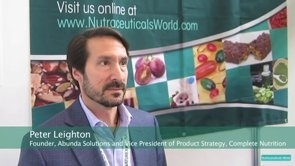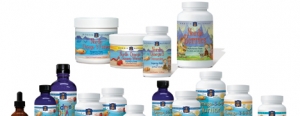To identify up and coming markets in the nutrition and nutraceutical sector, one must first take a broader view and apply a Darwinian perspective. When you examine Darwin's theory, what it really states is that the species that survive are not necessarily the strongest, smartest or biggest, but rather the species that prove to be most adaptive to their environment.
That said, one must then look at the environmental conditions in which species compete with one another to determine what adaptive changes will be needed to survive. In the case of the nutraceuticals market, the most important, if not the only, environmental condition affecting companies is the consumer.
Consumers drive political, social and economic changes around the world. Consumer empowerment has been the dynamic force in restructuring governments and companies the world over. One need only look at countries such as England, France and the former Soviet Union or companies such as IBM, Chrysler and Monsanto to see the impact of the consumer environment on its success or failure.
Put into the context of the nutraceutical market, it can be definitively stated that consumer lifestyle needs drive the market. Even in the world of pharmaceuticals, the biggest selling drugs are those designed for lifestyle enhancement- "Prozac" for mood enhancement and "Viagra" for sexual enhancement. Direct to consumer Rx/OTC advertising has proven exceedingly powerful in the commercial success of a drug, as drug companies have finally figured out that consumer empowerment is for real.
The Current Consumer Environment
With an aging educated "boomer" population looking to avoid the health conditions afflicting their parents and a desire to maximize their experiential wellness, there has been an unparalleled move towards fitness, self-care and nutrition. At the same time consumers have adopted a fast-paced and demanding lifestyle that will yield little compromise. These consumers have established specific expectations that cannot be easily altered; key among them are the requirements for convenience, information, taste and innovation.
In the early 1980's America began to see a growing trend toward fitness and athletic activity. This was an early sign of the consumer movement towards self-empowerment and increased quality of life. By the early 90's, consumers were taking more control of their lives and seeking other ways to improve their health and wellness. As of 1999, there were over 15,000 health clubs in the U.S. with about 30 million members. The fitness club industry holds over $10.6 billion in revenues.
There is now a definitive change in consumer focus from cure to prevention. Many consumers are turning into amateur physicians as they choose to self-treat and look at other nutritional stopgap solutions to their health problems. In 1996 $15 billion was spent on general practitioners while $80 billion was spent on alternative medicines. In 1998, complementary therapists outnumbered GP's in the U.K. In the U.S., 74 million Americans self-treat before seeing a physician. According to consumer research group HealthFocus, Des Moines, IA, "In general, anything that gives the consumer more control and more ability to self prescribe is going to do very well."
There is now considerable economic pressure for a prevention-based healthcare model as the U.S. healthcare system cost taxpayers over $1 trillion in 1996. In 1998, retail pharmacy prescription drug sales totaled $102 billion, an 85% increase in only five years. Promotion of healthier lifestyles can improve and extend lives while reducing healthcare costs and nutrition is a key to prevention. For example, the Journal of Cardiology found that taking vitamin E every day could save $578 per patient by protecting them from nonfatal heart attacks. A year's supply of micronutrient supplementation costs less than hospitalization for one day.
In 1994, in response to unprecedented consumer demand (more than three million letters to Congress), the federal legislature enacted the Dietary Supplement Health & Education Act (DSHEA). DSHEA was designed to provide consumers access to safe alternative healthcare products and scientific-based information to make informed choices of self-care. Subsequently dietary supplement sales exploded from $8 billion in 1993 to over $14 billion in 1999. In that period dietary supplements saw a CAGR of 13% versus a 6% growth rate for drugs and medicines. In the past year 85% of Americans have taken a dietary supplement, certainly demonstrating the proliferation of this form of self-care.
But dietary supplements are failing to deliver. After an initial love affair with this new form of self empowerment, consumers (and the media) are losing confidence in their efficacy, questioning their quality and becoming confused by their purported health claims. Besides, there is a finite number of pills a typical consumer will take and many people believe "pills are for sick people," limiting their use as a preventative and relegating them to a weak form of treatment. In fact, a recent report by Salomon Smith Barney illustrates a 5.3% year over year decline in dietary supplement sales, after six years of double digit growth. At issue are potential interactions with pharmaceutical drugs, poor manufacturing standards, inconsistent quality, misleading product information, unsubstantiated product claims and a poor level of scientific research supporting many dietary supplements.
Yet the consumer demand for a self-care solution remains strong. In a Darwinian viewpoint dietary supplements won't cease to exist, but their growth will be hampered by more innovative, convenient and experiential products. Mead Johnson's "Viactiv" soft calcium chew is an example of one such product, achieving first year sales in excess of $30 million and capturing 10% of calcium supplement sales.
A recent consumer survey from the Natural Marketing Institute, Telford, PA, demonstrates that there are many reasons why consumers are focusing on a healthy lifestyle. Key among them are "overall health" (72%), "prevention of disease" (46%) and to "gain energy" (33%). There is a growing segment of consumers dubbed "fast & healthy" that are searching for convenient products that suit their busy lifestyles, yet appeal to their need to self-care and eat healthy.
Functional Foods Activity
Functional foods are those purchased primarily because they deliver an additional health or nutritional benefit. Within this broad product area resides the likely successor to dietary supplements in the consumer need for self-care. Recent data from Food Marketing Institute/Prevention and HealthFocus bear out the opportunity for functional foods; the study shows that 9 out of 10 shoppers prefer naturally nutritious foods to dietary supplements. Sales of functional foods exceed $80 billion worldwide. In the U.S., nearly $15 billion was spent on functional foods in 1997 and the rate of growth is exceeding 12%.
With nearly 90% of all shoppers believing in the connection between diet and health, it is no wonder that 76% of them reported using functional foods in the last year and 95% of consumers believe certain foods have benefits that go beyond basic nutrition and may reduce the risk of certain diseases.
The integration of healthy and nutritious products into mainstream grocery is being driven by consumer demand as well as the grocery industry's need for greater growth and profitability; the CAGR for natural foods exceeds 10% versus a stagnant 3% growth for traditional foods.
Functional foods fall into three general types: those that are intrinsically nutritious and healthy, those foods that are fortified with additional nutrients and those that are specifically engineered for health benefits. With recent FDA-approved health claims for certain nutrients, many companies have moved to "call out" the inherent functionality of the foods they are selling and are fortifying their products with these approved nutrients. Fortifying foods that are consumed every day with functional ingredients provides another means for consumers to ensure that they receive optimal health benefits. Data shows that 81% of shoppers select foods for desirable nutritional components.
Functional foods are already making their mark in the grocery store:
� Heinz attributes a 4% 1999 share increase to the "call-out" marketing of lycopene, an ingredient found in ketchup.
� General Mills "Kix" breakfast cereal has seen a 17% sales increase as a result of recent nutrient fortification.
� Gardenburger's call-out of its use of soy protein resulted in a 25% sales increase and 44% distribution increase in the two months following FDA's approval of soy health claims.
� Since launching its Pure Premium juice line with calcium fortification, Tropicana has seen sales grow 173%.
Functional foods are geared for even greater success for a variety of reasons. Paramount among them is the ability of functional foods to deliver a lifestyle benefit to consumers without dramatically changing their behavior patterns. The consumer trends of nutritional personalization, simplified solutions and the importance of product taste and convenience all support growth. Additionally, consolidation of retail shelf space puts pressure on companies to provide innovation. While the market doesn't need another vitamin C or calcium supplement, it obviously wants more vitamin C-fortified orange juice and soft calcium chews.
According to the Food Marketing Institute, 77% of consumers believe nutrition is more important than price and 40% of shoppers will pay a premium for added nutritional value. This suggests tremendous consumer interest in self-care and desire for added product benefit; however as the "Benecol" experience will bear out, there is a definitive price/value relationship that cannot be exceeded. Nor are consumers willing to make a sacrifice on taste in order to improve health/wellness. If, however, the functional foods taste at least as good as their favorite food-and there is no incursion on their lifestyle-consumers will easily adopt the new product. The health proposition of functional foods is appealing only when it enables consumers to choose health at little or no extra cost.
Proprietary And Evidentiary Products
As the species of products currently known as dietary supplements evolves, it is likely that successors will be proprietary, evidence-based products. Ironically, the scientific tools used by pharmaceutical and biotechnology researchers, tools that can quantify and clarify the serious questions now surrounding most dietary supplements, have existed for many years. Until recently the scientific community had no interest in applying those tools to botanical compounds, believing that there was little merit to the efficacy of such products. Without those tools, the nutrition industry has found it difficult to create significant intellectual property around botanical products, leaving any invested research as "fair play" for others to use to their advantage.
To date, there have only been a limited number of products introduced into the nutritional supplement market that have been both clinically researched and patented. In the future, there will be a number of more highly researched and efficacious products capable of delivering differentiated, high value, proprietary products to the supplement, food and pharmaceutical markets and companies will begin to apply pharmaceutical research tools and methodologies to the nutritional market.
This scientific process will allow companies to launch effective, high value, defensible products that can be differentiated by marketers and trusted by consumers into the supplement and functional food markets. This means companies will utilize the tools, processes and scientific methodologies normally found in the pharmaceutical industry to develop highly effective and clinically proven supplements or food products, as well as the medical studies that provide clinical evidence of the efficacy and safety of specific compounds.
The Rise Of Medical Nutrition
One of the major stumbling blocks in the growth of dietary supplements has been the lack of endorsement and adoption by physicians and other healthcare professionals. Close to 60% of supplement users wish their primary care physicians could tell them more about dietary supplements and 35-40% said they would increase usage if they knew more about the products they take. Interestingly, only about 40% of medical schools require any nutritional curriculum and that number is decreasing.
Physicians just don't know, so they have been hesitant to give much nutritional advice. However, patients are looking toward their doctor for direction; 92% of Americans claim that physicians are their primary source of nutrition information. And the incidence of doctors giving nutritional advice rose from 49% in 1996 to 63% in 1998, most certainly a result of patient demands.
Nearly 40% of consumers reported using vitamins or minerals because a health care practitioner had recommended them and physician recommendations for a particular brand are followed almost 90% of the time. Twenty-five percent of Consumer Reports readers who tried an alternative therapy, including dietary supplements, did so on the recommendation of a doctor or nurse. This kind of data suggests an enormous opportunity to build sales based upon gaining the endorsement of healthcare professionals.
But the healthcare professional will only understand scientific data that is researched and presented in a familiar context. With large pharmaceutical companies now selling dietary supplements, and the increase in both the quantity and quality of nutrition research, it is likely that companies will begin to market these products in a manner more akin to Rx and OTC therapies, including the use of a professional detailing sales force. Another interesting phenomena will occur as a result of endorsement by physicians and healthcare professionals; the media will be more comfortable communicating favorable stories about these dietary supplements. According to the International Food Information Council, Washington D.C., the media is the most influential source of health information. Considering the media's impact on American consumers, and the patient's trust in their physician, these events will provide a domino effect and re-energize dietary supplement sales�at least for those products that are science-based (evidentiary and proprietary).
And as the medical community and the media begin endorsing specific dietary supplements, you can bet that economic (greed) factors will move third party providers such as HMO's to encourage and reimburse for their use. Studies are already bearing out the financial savings realized when an insurer can maintain a patient's health versus escalating costs for treatment. This area opens up a host of issues, especially in connection with recent developments in nutrigenomics and it will prove to be a major catalyst in the future growth of nutraceuticals.
Worldwide Nutrition Issues
We are witness to a worldwide nutrition problem that is escalating. There are 6.2 billion people in the world; 1.2 billion of them are undernourished and 1.2 billion are overnourished. The Western diet contains too much saturated fats, refined sugars and salt and not enough polyunsaturated fatty acids, fiber, antioxidants, micronutrients and phytoestrogens. The need exists for a Darwinian view of diet and nutrition as we continue to observe the slow degradation of our basic health and wellbeing at the hands of our own environmental influences.
There is significant scientific data surrounding the benefits of phytonutrients. Studies relating cancer prevention and intake of fruits and vegetables are significant: 206 human epidemiological studies and 22 animal studies. In 128 of 156 human studies reviewed, there was found a strong relationship between intake of fruits/vegetables and cancer prevention. Unfortunately, 91% of Americans don't get the minimum requirement of five servings of fruits and vegetables per day. Worse, 99% of American children don't get the USDA recommended number of servings from each of the five major food groups every day.
Over the past 50 years annual consumption of added sugars in the U.S. has increased by 45 pounds to 154 pounds per person. Eighty percent of the refined and processed sugars produced today go to the food and beverage industry, a reversal from the 1950's when most was used for home baking. Sugars are the number one food additive. Consumption of a major culprit, soft drinks, increased 130% between 1978 and 1995. This translates to a per capita soft drink consumption of 41 gallons in 1997.
The National Diet and Nutrition Survey (NDNS), a government study of U.K. school children, found that girls aged 15-18 consumed four times more sweets in weight than leafy greens; only 1/5 had consumed any citrus fruit within a week and children on average drank 75% more soda than milk. The main conclusions to be drawn from the NDNS are that many children are growing up with an unhealthy diet, eating too much salt, sugar and saturated fat and not enough vegetables and not receiving enough exercise.
The current crisis in nutrition is only fueling the growth of many up and coming markets in the nutraceutical sector. Like the evolutionary process theorized by Darwin, environmental conditions are signaling change and a select few companies will demonstrate their ability to adapt and thrive. NW
About the author:
Peter Leighton is vice president of marketing at Galileo Laboratories, Santa Clara, CA, a life sciences company involved in the research, identification and development of proprietary products that can be sold as nutritional supplements, functional foods or pharmaceuticals. Mr. Leighton can be reached at Galileo Laboratories, 5301 Patrick Henry Drive, Santa Clara, CA 95054; 408-654-5830; Fax: 408-654-5831; E-mail: pleighton@galileolabs.com; Website: www.GalileoLabs.com.





















